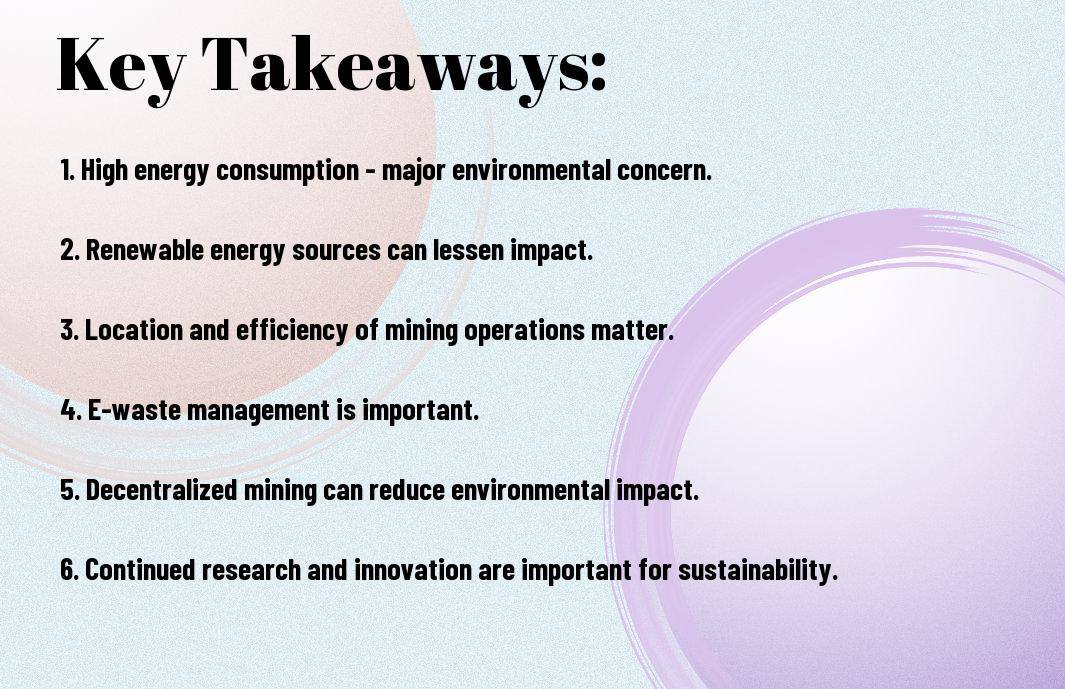
Newsletter Subscribe
Enter your email address below and subscribe to our newsletter

Enter your email address below and subscribe to our newsletter

It’s no secret that the rise of cryptocurrency mining has brought about significant environmental concerns due to its high energy consumption. As the popularity and value of digital currencies like Bitcoin continue to grow, so does the carbon footprint associated with their mining process. According to Investopedia, the environmental impact of cryptocurrency is a topic of increasing concern for sustainability advocates worldwide. In this article, we will explore the challenges posed by cryptocurrency mining on the environment and discuss potential solutions to mitigate its negative effects.


While cryptocurrency trading gains popularity, the backbone of cryptocurrencies like Bitcoin is mining. Cryptocurrency mining is the process of validating transactions on the blockchain and adding them to the public ledger. Miners use powerful computers to solve complex mathematical algorithms that verify the legitimacy of transactions. In return for their efforts, miners are rewarded with newly minted coins and transaction fees.
Any individual with a computer and internet connection can participate in cryptocurrency mining. However, the process has become significantly more competitive and resource-intensive over time. Miners compete to be the first to solve the algorithm and receive the reward, leading to a race for faster computing power. This competitive nature has led to the development of mining pools, where groups of miners combine their resources to increase their chances of solving the algorithm and sharing the rewards.
With the increasing difficulty of mining, mining farms have emerged as large-scale operations that host hundreds or even thousands of mining rigs in a single location. These farms require substantial amounts of electricity to power the mining rigs and keep them cool. The energy demand of mining farms has raised concerns about their environmental impact and sustainability.
Mining farms are often located in regions with cheap electricity to reduce operational costs. However, the sheer magnitude of energy consumption by these farms has led to debates about their contribution to carbon emissions and strain on local power grids. Finding a balance between the growing energy demand of mining farms and environmental sustainability is a pressing challenge in the cryptocurrency industry.

Despite the innovative and potentially transformative nature of cryptocurrencies, their mining process presents several environmental challenges that cannot be overlooked. From carbon footprint to e-waste concerns, the impact of cryptocurrency mining on the environment is substantial and requires urgent attention.
Cryptocurrency mining operations are energy-intensive, consuming vast amounts of electricity. This high energy demand results in a significant carbon footprint and contributes to greenhouse gas emissions. The process of validating transactions and securing the network involves complex mathematical puzzles that miners compete to solve, requiring powerful hardware and ultimately leading to high energy consumption.
Consumption of electronic resources is a critical concern in cryptocurrency mining. As technology advances rapidly, mining rigs become obsolete quickly, leading to a rapid turnover of hardware and generating electronic waste. The components of these rigs contain valuable resources that are often not recycled properly, further exacerbating the environmental impact.
The consumption of energy and resources in cryptocurrency mining is unsustainable in the long run. Finding more efficient ways to mine cryptocurrencies while reducing e-waste is vital to mitigate the environmental impact of this industry.
Emissions from cryptocurrency mining activities can have a detrimental effect on local ecosystems and water resources. The release of greenhouse gases and other air pollutants can contribute to air and water pollution, disrupting the natural balance of these fragile environments. Furthermore, the high energy consumption of mining operations can strain local water resources, especially in areas where water scarcity is already a concern.
It is crucial to consider the impact of cryptocurrency mining on local ecosystems and water resources. The extraction of resources for mining hardware, along with the disposal of electronic waste, can lead to soil and water contamination, affecting biodiversity and the overall health of ecosystems in mining regions. Adequate regulatory measures and sustainable practices are necessary to protect these vital resources from irreversible damage.
Greenhouse gas emissions and resource consumption are not the only environmental concerns associated with cryptocurrency mining. Noise pollution generated by the continuous operation of mining hardware can disturb local communities and wildlife, impacting their well-being and habitats. Finding ways to mitigate noise pollution from mining facilities is vital to foster harmony between cryptocurrency operations and surrounding environments.
After the rise of cryptocurrencies, particularly Bitcoin, the energy consumption associated with cryptocurrency mining has become a subject of concern. The Growing Energy Requirements of Proof of Work (PoW) algorithms, which are used by many cryptocurrencies to validate transactions and create new coins, require significant computational power. This has led to an exponential increase in energy consumption as more miners join the network, competing to solve complex mathematical problems to earn rewards.
To address the environmental impact of energy consumption in cryptocurrency mining operations, the source of energy used plays a crucial role. Mining operations rely heavily on electricity, with a significant portion sourced from non-renewable energy such as coal and natural gas. However, there is a growing trend towards using renewable energy sources such as solar, wind, and hydroelectric power to power mining operations.
As the demand for cryptocurrencies grows, so does the need for energy to power mining operations. The environmental impact of using non-renewable energy sources is concerning due to the carbon footprint associated with mining activities. In contrast, utilizing renewable energy sources can significantly reduce the carbon footprint of cryptocurrency mining and pave the way for a more sustainable future.
The geopolitical aspects of energy supply have a significant impact on cryptocurrency mining operations. The access to affordable and reliable energy sources can influence the location of mining farms and the overall profitability of mining activities. Countries with abundant and cheap energy sources tend to attract more miners, leading to concerns about centralization and dominance of certain regions in the global mining network.
Another important consideration is the dependency of cryptocurrency mining on specific energy sources controlled by governments or corporations. Geopolitical tensions and policy changes can disrupt energy supply to mining operations, affecting the stability and security of the cryptocurrency network. Diversifying energy sources and promoting energy independence are crucial steps in addressing the geopolitical challenges associated with cryptocurrency mining.
Impact The Environmental Effects of Cryptocurrency Mining in the industry have raised concerns about the excessive energy consumption associated with proof of work (PoW) algorithms. As a response, many cryptocurrencies are transitioning to alternative consensus mechanisms like Proof of Stake (PoS) to reduce their carbon footprint. Proof of Stake requires validators to hold a certain amount of cryptocurrency as stake to validate transactions, significantly lowering the energy requirements compared to PoW.
Any advancements in technology have also led to the development of energy-efficient mining hardware, helping to lessen the environmental impact of cryptocurrency mining. These innovative hardware solutions are designed to optimize mining processes while consuming less energy. Manufacturers are focusing on creating more energy-efficient ASICs (Application-Specific Integrated Circuits) and GPUs (Graphics Processing Units) for mining, reducing the overall electricity consumption of mining operations.
For sustainable mining practices, the recycling and upcycling of mining equipment play a crucial role in minimizing electronic waste generated by obsolete hardware. By refurbishing old mining rigs or components, miners can extend the lifespan of equipment and reduce the environmental impact of disposing of electronic waste. This approach not only benefits the environment but also promotes a circular economy within the cryptocurrency mining industry.
Global regulations on energy consumption for cryptocurrency mining are becoming increasingly important as the environmental impact of mining becomes more evident. Many countries are starting to implement stricter regulations to reduce the carbon footprint of mining operations. Measures such as limiting energy consumption or mandating the use of renewable energy sources are being considered to tackle the high energy consumption of mining activities.
Sustainable mining practices are imperative for the long-term viability of cryptocurrency mining. Governments and industry stakeholders are exploring incentives to encourage miners to adopt more sustainable practices. These incentives can range from tax breaks for using renewable energy sources to subsidies for investing in energy-efficient mining hardware.
For instance, some countries are offering grants to miners who implement carbon-neutral mining operations or rewarding those who offset their carbon emissions through reforestation projects.
Energy efficiency is a key focus when considering the environmental impact of cryptocurrency mining. The use of carbon credits and offsetting mechanisms can help mitigate the carbon footprint of mining operations. Miners can purchase carbon credits to offset their emissions or invest in projects that remove carbon dioxide from the atmosphere, such as reforestation initiatives.
Regulations are crucial in ensuring that miners are held accountable for their energy consumption and carbon emissions. By implementing strict regulations and incentivizing sustainable practices, the cryptocurrency mining industry can move towards a more environmentally friendly future.
Keep in mind that grassroots movements play a significant role in promoting sustainable mining practices within the cryptocurrency industry. These movements, driven by environmentally-conscious community members and organizations, advocate for the adoption of renewable energy sources, energy-efficient hardware, and responsible mining practices. By raising awareness and pressuring mining operations to prioritize sustainability, grassroots initiatives are instrumental in shaping a more environmentally friendly industry.
On the corporate front, many cryptocurrency companies are recognizing the importance of environmental sustainability and are committing to green initiatives. These companies are pledging to reduce their carbon footprint, invest in renewable energy projects, and offset their emissions through carbon credits. The shift towards corporate responsibility in the crypto industry is a positive step towards mitigating the environmental impact of mining activities and fostering a more sustainable future for digital currencies.
The corporate responsibility and green pledges in the crypto industry involve companies taking proactive steps to address the environmental challenges associated with mining. By integrating sustainability into their business practices and pledging to prioritize eco-friendly initiatives, these companies are setting a precedent for responsible conduct within the industry.
Green Collaborative efforts among key stakeholders in the cryptocurrency sector are vital for establishing and upholding environmental standards. By working together, industry participants, regulators, and environmental organizations can develop guidelines and best practices that promote sustainable mining operations. These collaborative initiatives aim to create a framework that balances the growing demand for cryptocurrencies with the need to protect the planet’s fragile ecosystems.
Sustainable A crucial aspect of collaborative efforts for environmental standards in cryptocurrency is ensuring transparency and accountability across the supply chain. By setting clear guidelines and monitoring compliance, stakeholders can hold mining operations accountable for their environmental impact and drive continuous improvement towards sustainability.

Many emerging technologies have the potential to revolutionize the landscape of cryptocurrency mining and its environmental impact. Technologies such as
artificial intelligence (AI)
,
edge computing
, and
quantum computing
are being explored to enhance the efficiency of mining operations and minimize energy consumption. These advancements hold promise for reducing the carbon footprint of cryptocurrency mining activities.
The emergence of DeFi platforms presents a unique opportunity to incorporate sustainable practices into cryptocurrency mining activities. DeFi platforms leverage blockchain technology to create transparent and efficient financial systems that can reward miners for adopting environmentally friendly practices. By incentivizing eco-friendly mining techniques and fostering community-driven governance, DeFi can play a significant role in promoting sustainability within the crypto mining industry.
Future advancements in technology and shifting regulatory landscapes are anticipated to shape the evolution of cryptocurrency mining. As the industry continues to mature, we can expect to see a greater emphasis on energy-efficient mining practices, the adoption of renewable energy sources, and the development of innovative consensus mechanisms that prioritize sustainability. These changes will likely lead to a more environmentally conscious approach to cryptocurrency mining in the years to come.
DeFi has the potential to revolutionize the way cryptocurrency mining is conducted, offering a pathway towards a more sustainable future for the industry. By leveraging decentralized financial solutions, miners can not only optimize their operations but also contribute to mitigating the environmental impact of their activities. It is imperative for the industry to embrace these advancements and prioritize sustainability to ensure the longevity and relevance of cryptocurrency mining in a rapidly evolving digital landscape.
Hence, the environmental impact of cryptocurrency mining is a pressing issue that requires immediate attention. The carbon footprint, energy consumption, and e-waste generated by mining activities pose significant challenges to sustainability efforts worldwide. However, there are solutions that can help mitigate these impacts, such as transitioning to renewable energy sources, implementing more energy-efficient mining technologies, and promoting responsible e-waste disposal practices.
By addressing these challenges and implementing sustainable solutions, the cryptocurrency industry can reduce its environmental impact and contribute to a more eco-friendly future. It is crucial for stakeholders, including miners, regulators, and investors, to work together to ensure that mining activities are conducted in a way that is both profitable and sustainable for the planet.
A: Cryptocurrency mining has a significant environmental impact due to its high energy consumption, which contributes to carbon emissions and strains on energy resources.
A: The process of mining cryptocurrencies requires powerful computers that consume large amounts of electricity, much of which is generated from fossil fuels, leading to carbon emissions.
A: Challenges include increased energy consumption, carbon footprint, e-waste generation, and strain on local energy infrastructure in regions where mining operations are concentrated.
A: Solutions include transitioning to renewable energy sources, implementing more energy-efficient mining technologies, promoting responsible mining practices, and exploring consensus mechanisms that are less energy-intensive.
A: By using renewable energy sources such as solar, wind, or hydroelectric power, the carbon footprint of cryptocurrency mining can be significantly reduced, making it more sustainable in the long run.
A: Governments can implement policies to incentivize or mandate the use of renewable energy sources for mining operations, set energy efficiency standards for mining equipment, and monitor compliance with environmental regulations.
A: The cryptocurrency community can advocate for sustainable practices, support eco-friendly mining initiatives, engage in discussions on energy-efficient consensus mechanisms, and raise awareness about the importance of reducing the environmental impact of mining.